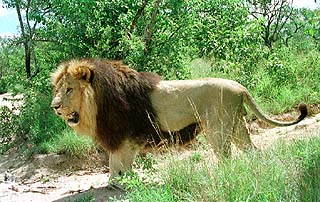
The cheetah at the Centre are serologically free of feline immunodeficiency virus infection (FIV), corona virus (feline infectious peritonitis [FIP]) and feline leukaemia virus (FeLV). All cheetah are vaccinated annually against feline panleukopenia, feline rhinotracheitis virus and calici virus. New arrivals are quarantined for at least six weeks and only admitted after being certified free of specified diseases. The cheetah are also maintained free of external and internal parasites. The nutritional status and dietary supplements of the animals are monitored carefully to ensure an optimal and balanced nutritional state. By advising clients on the feeding of cheetah, the Hoedspruit Research and Breeding Centre endeavours to ensure that the high standard of the nutritional state of the animals is maintained.
Animals for sale:
The Barbary lion The Hoedspruit Centre is currently home to three lions that are believed to be Barbary or Cape lions. The animals were confiscated by the Mozambique government after a circus owner was found guilty of neglecting the animals. The original Cape lion did not survive long into the second half of the 19th century and was the first of the African lion subspecies to become extinct. It is believed that most of the lions found in Southern Africa were a subspecies known as the black-maned lion of the Cape, or the Cape lion. The physical appearance of this lion differed from that of the lions occurring in southern and east Africa today. Researchers have not been able to ascertain whether the extinct Cape lion and Barbary lion are indeed different subspecies.
Contact has been made with the Cat Specialist Group and specifically with Peter Jackson of the IUCN in Gland, Switzerland. According to Mr Jackson there is a worldwide interest in the lion (Panthera leo) and its subspecies. Scientific research is being done regarding extant and extinct lion species.
Persons involved with safari parks, zoos and circuses who might be able to assist the Hoedspruit Research and Breeding Centre for Endangered Species with information are kindly requested to contact the Centre.
The Centre is a unique South African tourist attraction. Guided tours are conducted hourly, starting with a video presentation in the auditorium. More than 80 cheetah, including tame individuals, cubs and the extremely beautiful king cheetah can be viewed. The tour brings you in close contact with three of the Big Five as well as species such as the wild dog, serval, caracal, black-footed cat, aardwolf, ground hornbill, blue crane, African wild cat, and vultures at the vulture restaurant. The residing Barbary lion, young rhinos and buffaloes can also be viewed. The duration of the tour is 90 minutes, ending at reception where guests can browse through the curio shop and visit the information centre. The Hoedspruit Centre can be visited from Monday to Saturday (8:00 - 16:00) as well as on Sundays and during school holidays. Booking in advance is not required but recommended for groups numbering ten persons or more.
|
 Discover Africa Safari Travel Reisen |






